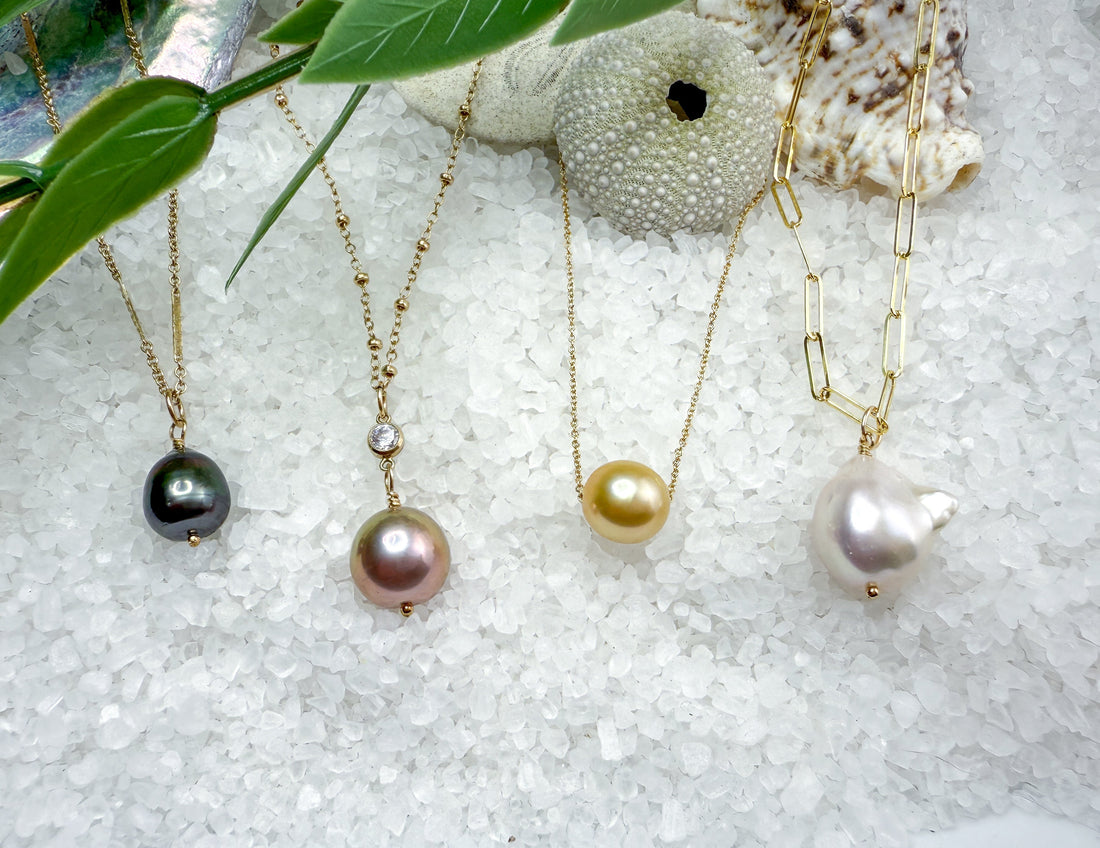
The Ultimate Guide to Saltwater vs. Freshwater Pearls
Pearls may seem similar at a glance, but saltwater and freshwater pearls each offer something beautifully different.
This guide breaks down everything you need to know—from origin, shape, and color to luster and price—so you can choose with confidence and style. We’re also diving into two standout varieties: Edison pearls (freshwater’s bold beauty) and Tahitian pearls (saltwater’s exotic gem). From ocean to heirloom, inspired by nature and made to last—discover your new favorite pearls.
1. Origin
Freshwater Pearls
Grown in lakes, rivers, and ponds—mostly in China. Freshwater mussels can produce multiple pearls at once.
Saltwater Pearls
Cultivated in protected bays and lagoons in the ocean—commonly in Japan, French Polynesia, Australia, and the Philippines. Saltwater oysters usually produce only one pearl at a time.
2. Shape
Freshwater Pearls
Often more baroque (irregular) in shape, though round ones are available thanks to better farming techniques. They are formed around natural materials which makes their shape more irregular.
Saltwater Pearls
More commonly round or near-round, especially Akoya pearls (established with a technique originally discovered by Kokichi Mikimoto in Japan in the 1890’s). Saltwater pearls are formed around a spherical bead, emphasizing symmetry and a smooth finish.
Dispelling the myth: Many people mistakenly believe that all saltwater pearls are natural while all freshwater pearls are cultured. In reality, both saltwater and freshwater pearls are usually cultured—meaning they’re formed with human assistance. Truly natural pearls are extremely rare in both cases!
3. Luster (Shine)
Freshwater Pearls
They are formed with layers of nacre that form faster and the pearl is more dense. They have a soft, dewy luster.
Saltwater Pearls
Saltwater pearls are made up of thinner layers of nacre that slowly form around a solid foundation. This gives the saltwater pearl a brilliant, lustrous shine—especially Akoya and Tahitian pearls.
4. Color
Freshwater Pearls
Freshwater pearls mimic the inner nacre of the shell they’re grown in. They naturally range in white, peach, lavender, and pink. They can also be dyed in vibrant colors.
Saltwater Pearls
Saltwater pearls come in a more limited natural palette. Examples include:
- Akoya: white or cream with rose or silver overtones
- Tahitian: black, gray, green, and peacock
- South Sea: white, silver, or gold
5. Price
Freshwater Pearls
Generally more affordable due to their abundance and shorter culturing time. Between 6 and 120 pearls can form in a single mollusk.
Saltwater Pearls
Higher in price due to rarity, longer culturing time, and higher luster. There are strict rules and regulations that limit the amount of saltwater pearls that pearl farmers can generate in any given year. As a result, saltwater pearls are harder to farm and more scarce, which ultimately makes them more expensive than freshwater alternatives.
Meaning & Energy
Freshwater pearls are often associated with:
-
Emotional renewal
-
Compassion and nurturing energy
-
Youthfulness and simplicity
-
New beginnings or fresh chapters
Their softer, organic shapes and gentle glow give them a more approachable and understated feel—ideal for someone drawn to authenticity, softness, or a more casual elegance.
Saltwater pearls (like Akoya, Tahitian, and South Sea) are often linked with:
-
Wisdom and inner strength
-
Elegance and refinement
-
Emotional balance and clarity
-
A deep connection to nature and the ocean
Because they form under more complex conditions, they're sometimes seen as representing resilience, transformation, and a deeper spiritual journey.
Edison Pearls vs. Tahitian Pearls
Now let’s take a closer look at two of my personal favorites—Edison (Freshwater) and Tahitian (Saltwater) pearls. These beauties aren’t just stunning to wear—they’re the kind of pieces you’ll enjoy for years and maybe even pass down one day.
Edison Pearls
- Type: Freshwater (innovative cultured pearl from China)
- Size: Often 11–16mm, sometimes larger
- Shape: Round to near-round
- Color: Wide range—white, pink, lavender, gold, even metallic shades
- Luster: High for freshwater pearls; similar to saltwater pearls
- Price: More affordable than Tahitian pearls of similar size
Why Choose Edison Pearls?
You get large, bold pearls with beautiful luster and color at a lower price point—great for modern statement jewelry.
Tahitian Pearls
- Type: Saltwater (from black-lipped oyster in French Polynesia)
- Size: Typically 8–14mm
- Shape: Round, drop, or baroque
- Color: Natural dark tones—black, gray, green, peacock, aubergine
- Luster: Very high and reflective
- Price: Higher due to rarity and exotic appeal
Why Choose Tahitian Pearls?
They’re known for their dramatic colors and elegance—perfect for luxury jewelry and formal wear.
Final Thoughts
Whether you love the unique charm of Freshwater Edison pearls or the exotic allure of Tahitian pearls, there’s a perfect pearl out there for every taste and budget. Understanding the differences helps you make a more informed and personal choice.






